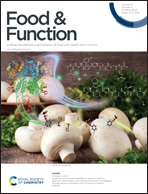Filamentous fungal pellets as a novel and sustainable encapsulation matrix for exogenous bioactive compounds†
Abstract
Edible filamentous fungi (FF) are considered sustainable food materials given their rich nutrient profile and low carbon and water footprints during production. The current study evaluated FF biomass as a natural encapsulation system for exogenous bioactive compounds and as a model system to investigate the complex food matrix–micronutrient interactions during in vitro digestion. Our objective was to compare the fungal pellet, as a multicellular encapsulation system, with single yeast cell-based carriers in terms of loading and release of curcumin, a model compound. The results suggest that the curcumin encapsulation efficiency was similar in single yeast cells and fungal hyphal cells. A vacuum treatment used to facilitate the infusion of curcumin into yeast or fungal cells also enabled rapid internalization of yeast cells into the fungal pellet matrix. Compared to the single-cell encapsulation system, the multicellular systems modified the release kinetics of curcumin during in vitro digestion by eliminating the initial rapid release and reducing the overall release rate of curcumin in the small intestinal phase. These results provide a deeper understanding of the effect of natural edible structures on the bioaccessibility of micronutrients, and demonstrate the potential of using FF biomass as functional food materials.



 Please wait while we load your content...
Please wait while we load your content...